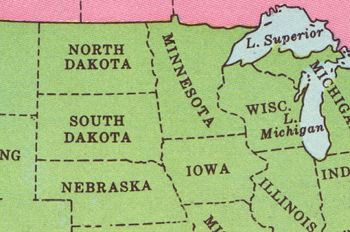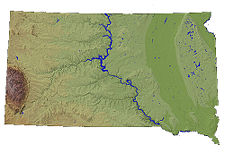South Dakota (U.S. state): Difference between revisions
imported>James F. Perry (→Agriculture and livestock: start content of section) |
(minor revision + update pop.) |
||
| Line 2: | Line 2: | ||
[[Image:North mid west.jpg|right|350px]] | [[Image:North mid west.jpg|right|350px]] | ||
'''South Dakota''' is one of the states | '''South Dakota''' is one of the constituent states of the [[United States of America]]; it is located on the northern [[Great Plains]] in the north central portion of the United States. Its area is 77,116 sq miles (199,730 square kilometers). Its population (2020 census) was 886,667. The capital is located in [[Pierre, South Dakota|Pierre]]. | ||
==Land== | ==Land== | ||
Revision as of 14:09, 5 November 2022
South Dakota is one of the constituent states of the United States of America; it is located on the northern Great Plains in the north central portion of the United States. Its area is 77,116 sq miles (199,730 square kilometers). Its population (2020 census) was 886,667. The capital is located in Pierre.
Land
Physiography (land forms)
South Dakota is divided into three separate regions. The main division is demarcated by the Missouri River which flows through the center of the state from north to south dividing the state into an eastern and a western region.
The eastern poriton of the state was formed by glacial deposition and is generally flat with a very slight rise as one travels from east to west.
West of the Missouri, the land continues to rise, but at a slightly steeper rate, from about 2000 feet above sea level at the Missouri River to over 3000 feet in elevation in the extreme northwest part of the state. This region is part of the Great Plains.
The third distinct region is the Black Hills area in the southwestern part of the state. This is a mountainous region, covered by a pine forest, and was sacred to the native peoples of the Great Plains.
Rivers and drainage, lakes
Climate
Governing the climate in South Dakota is the fact that the state does not lie close to any large bodies of water and thus does not experience the moderating influence of such formations on overall weather patterns. As a result, South Dakota experiences hot summers and cold winters with larger than normal seasonal and diurnal fluctuations in temperature.
During the peak summer months, mean daily maximum temperatures will be in the mid to upper 80s (degrees F) while during the winter months mean daily lows will be in the teens or single digits (degrees F).
Annual precipitation averges range from 25 inches plus in the southeast portion of the state, decreasing gradually as one goes across the state from the east to the semi-arid west where the average annual preciiptation will be less than 17 inches.
Soil
Flora
Natural resources
Demographics
- including native peoples
Politics and government
Elected officials
For most of its history, South Dakota has been a strongly Republican state. Since gaining statehood in 1889, the state has supported the Republican ticket in the quadrennial Presidential elections 26 times in 30 contests, including the last 11 times in succession.
At the state level, the Governor's office has been occupied by a Republican for all but 9 of the past 74 years. The current governor of the state, M. Michael Rounds, a Republican from Pierre, is in his second term of office, having been elected to the post in 2002 and re-elected in 2006.
The state legislature is elected from 35 districts, each of which elects 2 members to the state House of Representatives and 1 member to the State Senate. The legislature meets annually with members, both of the House and of the Senate, serving for 2 years each before having to stand for re-election. Currently the state House of Representatives consists of 46 Republicans and 24 Democrats while the state Senate consists of 21 Republicans and 14 Democrats. The state legislature meets annually with members serving for 2 years.
The only elective offices for which the Democrat's have enjoyed some success are the offices of U.S. Senator and Representative, especially the former. The Democrats have actually won the majority of elections to the U.S. Senate over the past 50 years and currently hold one of the two U.S. Senatorial positions allocated to each state. As well, the state's lone at-large representative to the U.S. House of Representatives is a Democrat, Stephanie Herseth Sandlin, first elected in 2004 and re-elected every time since.
Finance and taxation
Current issues
Economy
Agriculture and livestock
Agriculture is the leading economic industry in South Dakota. Around 88.5% of the total land area in South Dakota is in farmland. Of the approximately 43.7 million acres of farmland, about 19.1 million acres are in crops and slightly over 23 million acres are devoted to pasteurland.
The state ranks in the top 10 among U.S. states in the production of 25 agricultural commodities. The Sioux Falls stockyards is the largest livestock terminal in the United States.
The chief crops are corn, soybeans, oats, wheat, sunflowers, and sorghum. Principal livestock include cattle and calves (3.7 million total), sheep and lambs (305,000), hogs and pigs (1.3 million) and 90,000 milk cows producing about 1.8 billion pounds of milk per year (all these are 2008 figures).
Industry (manufacturing)
Financial industry
Mining
Tourism
Transportation
Social, cultural, and educational
Education
The University of South Dakota, situated in Vermillion, opened in 1882. South Dakota State University in Brookings was established in 1881.
Media
Libraries
Arts
Religion
Parks and recreation
Points of interest
The most important tourist attraction of the state is Mount Rushmore National Memorial, in the Black Hills. Here 60 feet (18 m) high heads of four former United States presidents can be admired: George Washington(1732–1799), Thomas Jefferson (1743–1826), Theodore Roosevelt (1858–1919), and Abraham Lincoln (1809–1865).

